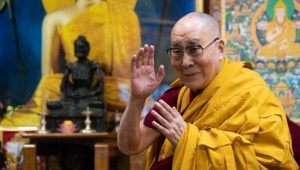
Not too long ago, Pure Land Buddhist scholar Jeff Wilson suggested I would do well to profile the work of Kira Jade Cooper, an environmental scientist at the University of Waterloo who has developed an assessment model for evaluating the efficacy of inner-transformation techniques—such as mindfulness meditation—in the context of community and organizational development, and also beyond, in application of the United Nations’ Sustainable Development Goals.
I reached out to Kira and after a Zoom call sent her some questions about her work, sparked by our discussion. Here’s a slightly edited version of our correspondence.
BDG: You come from a hard science background and describe yourself as sitting at a variety of tables. Please tell us more about that.
Kira Jade Cooper: I have yet to find a single basket that can contain my broad and at times bizarre research interests that cover topics including fish herpes, contaminant mobilization, ecosystem health, systems change, mindfulness, and sustainability transformations. More recently, I have been exploring the nexus of inner and outer sustainability and the extent to which shifts in mindsets, values, and worldviews might catalyze systemic change toward long-term viability. By sitting at many seats at many tables, I have been immensely fortunate to learn from many folks both at the academy and beyond.
BDG: Where do you find your Buddhist inspiration for the work you do?
KJC: I do not have a formal practice with a particular sangha. However, I have been immensely fortunate to have found kindred spirits in diverse communities that are working in the sustainability field. In these spaces, I have witnessed a variety of applications of Buddhist and/or post-Buddhist practices that are being used to encourage more conscious and sustainable ways of being.
BDG: Please elaborate on your framework for evaluating the effectiveness of inner transformation in the outer transformation of organizations, and the goal of that assessment tool.
KJC: My most recent research has focused on examining the burgeoning field of inner transformation as a catalyst for sustainability progress. Specifically, I am curious about to what extent and how different approaches for “inner” change drive “outer” change. Given the rapid surge in interest to accelerate progress for achieving the Sustainable Development Goals (SDGs) via inner transformation, I thought it prudent to develop an assessment model to ensure that interventions for change align with broad sustainability requirements. The framework is, in essence, a contextually adaptable tool for evaluating how interventions for inner transformation support outer transformation.
BDG: As important as the work of David Loy, Joan Halifax, and Stephanie Kaza has been to plant the seeds of Green Buddhism, it is still an outlier practice. What needs to change and how could you apply your perspective to Buddhist organizations?
As a non-Buddhist, I am hesitant to prescribe any changes to Buddhist communities. What is apparent, however, is that for Buddhism to support sustainability progress, it will need to endeavor to take positive action off the cushion. If Buddhist practitioners are committed to positively contributing to sustainability progress, I would suggest the following as some initial steps.
Firstly, and most ambitiously, ensure that the teachings align not only with personal but planetary well-being. While there might be some cascading positive effects resulting from individual attentional regulation or compassion practice, it is unlikely that these will organically scale globally and drive the kinds of behavior change needed to avert further socio-ecological crises. There is also likely a need to surface and transform unsustainable practices and traditions that have endured.
Along this vein, Buddhist groups may wish to investigate current practices within places of worship and what can be changed to reduce their environmental footprints. Are there old practices that are generating excessive waste or consuming resources that could be transformed? Are there rituals that are archaic and perhaps causing suffering? What kinds of changes could be made that would benefit the community; e.g., reduce parking lot space and create community or pollinator garden.
BDG: How would you explain what you do to a high school class?
KJC: I am interested in what can make people treat each other and nature with more kindness and respect. To better understand this, I am researching how the ways that we think about our relationships with people, places, and the planet affect our behaviors. Another piece of my research puzzle is trying to discover how we can better share the planet with non-humans and cause less suffering to other species.
BDG: Eco-anxiety is a term that has entered public discourse now. Beyond conscious collapse, what can Buddhist perspectives offer in the way of a positive, realistic future scenario?
KJC: I do not believe that I could, in good conscience, offer a realistic future scenario that would be conceived as “positive” given the current state and future trajectory of social and biophysical systems. Allow me to clarify. For me, “positive” is equated with ensuring a just and equitable world for our species and the more-than-human world. And realistically speaking, we are nowhere near on track for that kind of scenario.
That aside, Buddhist perspectives related to dependent co-arising and impermanence are likely very constructive framings for people attempting to make sense of the profoundly complex interdependent challenges facing humanity. Not only do they offer a systemic approach to conceiving challenges, but also the acceptance that all things are impermanent, and that change is inevitable. Practices geared toward cultivating empathy and compassion are also valuable in a world that is becoming increasingly polarized and volatile. Additionally, I see the role of the sangha as an integral place of refuge, safety, and support where people can draw strength and healing as they navigate these challenges.
BDG: Where do you see congruencies and divergences between Buddhist and Indigenous ways of knowing?
KJC: This is a very difficult question to answer, and I feel it is essential to foreground my response with a disclaimer. Both “Buddhist” and “Indigenous ways of knowing” gesture toward a rich and highly diverse plurality of understandings. In good conscience, I would be remiss to homogenize either Buddhist or Indigenous knowledge systems into singular conceptions as there are many Buddhisms and many Indigenous knowledge systems.
This question surfaces a deep issue that I have noticed in the inner transformation space—the desire to simplify and tokenize a particular wisdom tradition for the purposes of solving highly complex sustainability-related issues. Not only does this oversimplification fail to recognize the profound differences between paths—e.g., Theravada versus Mahayana versus Vajrayana—but also the diverse trainings within each school and sangha.
With that being said, I have seen strong synergies between many versions of Buddhism and Indigenous knowledge systems, particularly around concepts related to complexity.
A pattern I have witnessed across many disciplinary lenses in Western academia is the desire to disentangle system elements into isolated units of analysis. A key challenge with this model is that the transcontextual richness—that which emerges in relationship and across contexts—is lost. The process of tearing “things” apart for dissection is insightful in certain fields for certain applications. Where it becomes less helpful and even detrimental to well-being, is when this process becomes a mental model for understanding all phenomena in isolation. When complex challenges such as climate change are viewed through a reductionist lens, their solutions are as well. As history has demonstrated on numerous occasions, oversimplified solutions can be dangerous and weaponized to serve narrow interests.
Buddhism offers many practices to help cultivate capacities that align with greater complexity tolerance including attentional regulation, compassion, and empathy. It is my sense that when approached with the intention of reducing collective suffering, these competencies could enrich the combined potential of the collective to respond less reactively to existential threats.
However, in order to be truly in service to enabling conditions for long-term viability, a recontextualization of many Buddhist practices would likely be needed to shift from individual to collective interests and move toward what has been described in Indigenous knowledge as right relationship.
Right relationship, as I have come to understand, refers to a way of being that recognizes oneself as a member of a system within systems. It implies not only seeing oneself in the vast complexity of all life but also acting with agency from a place of responsibility, accountability, and reciprocity therewith to nurture conditions for present and future generations.
Complexity tolerance in this case, although not explicitly cultivated through seated meditation as in many Buddhist practices, also involves a combination of focused attention, discipline, and contemplation—although I use the latter term very loosely.
In my understanding, right relationship might also be understood as a conscious expression of kinship with the more-than-human world. Where many Buddhist texts speak to soteriological frameworks for self-transcendence, I have found that Indigenous knowledge is more strongly oriented toward long-term and collective flourishing. Unfortunately, in both instances, these rich traditional wisdoms are often appropriated and commodified in ways that are not generative to sustainability.
BDG: In the best of all possible worlds, what do you see yourself doing in 10 years?
KJC: As a researcher in the environmental field, it is my hope that in the next decade, my job will be obsolete. . . . That all human actions are aligned with collective and long-term interests, and that there is no need for someone such as myself to study sustainability transformation as this would be the norm. In the “best” best of all possible worlds, I would hope to see that the biosphere has recovered from anthropogenic damage and that degraded ecosystems are flourishing. Similarly, that geo-political disputes are resolved before further escalation ensues, and that processes of healing are underway around the world. In summary, it is my hope and prayer that in ten years from now I have the pleasure to share with you a story of interbeing, right relationship, and collective flourishing.
See more
International Conference on Environmental Mindfulness
Inner Development Goals
A Novel Framework for Inner-Outer Sustainability Assessment (MDPI)
How Do Mindfulness Offerings Support Inner–Outer Sustainability Progress? A Sustainability Assessment of Online Mindfulness Interventions (MDPI)
Cultivating Inner Capacities for Regenerative Food Systems Rationale Report, United Nations Development Program (UNDP)
Related features from BDG
Buddhist Voices in the Climate Crisis: The Eightfold Path of Sustainability
For the Earth: Buddhist Environmental Thought and Activism
“Our House Is Still on Fire:” World Economic Forum 2020 Convenes on the Topic of Sustainability
Buddhism and Sustainability: A Conversation with Green Monday Founder David Yeung
Bhutan, the World’s Only Carbon-negative Nation, an Example of Environmental Stewardship for a Planet Grappling with Climate Change Environmental Concern in the Discourses of Dīgha Nikāya
Sustainability and Wellness: What are we even talking about?














